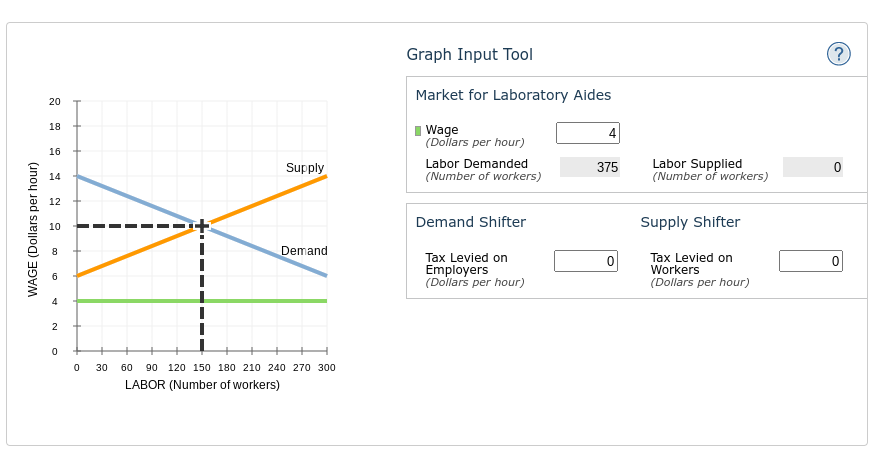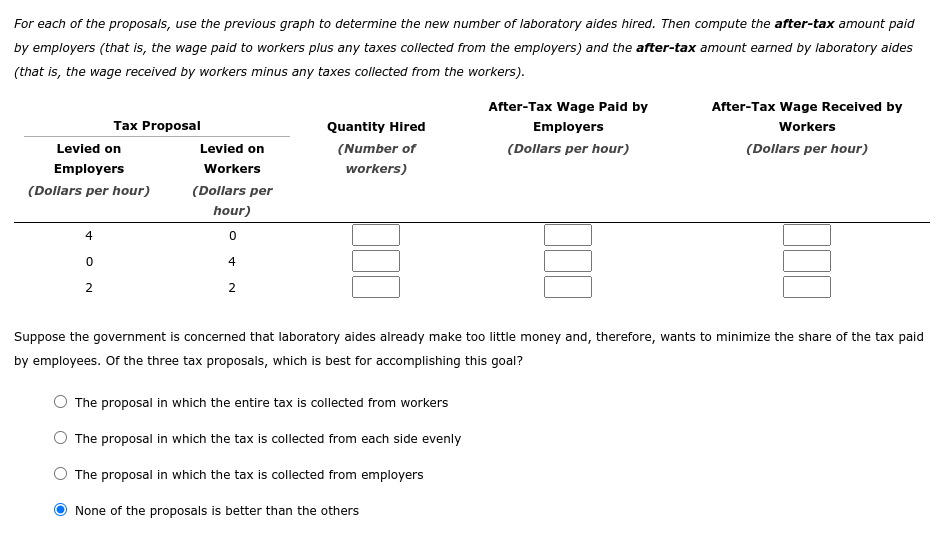(ALL OWNERSHIP GOES TO CENGAGE) The following graph gives the labor market for laboratory aides in the imaginary country of Sophos. The equilibrium hourly wage is $10, and the equilibrium number of laboratory aides is 150. Suppose the federal government of Sophos has decided to institute an hourly payroll tax of $4 on laboratory aides and wants to determine whether the tax should be levied on the workers, the employers, or both (in such a way that half the tax is collected from each party). Use the graph input tool to evaluate these three proposals. Entering a number into the Tax Levied on Employers field (initially set at zero dollars per hour) shifts the demand curve down by the amount you enter, and entering a number into the Tax Levied on Workers field (initially set at zero dollars per hour) shifts the supply curve up by the amount you enter. To determine the before-tax wage for each tax proposal, adjust the amount in the Wage field until the quantity of labor supplied equals the quantity of labor demanded. You will not be graded on any changes you make to this graph. Note: Once you enter a value in a white field, the graph and any corresponding amounts in each grey field will change accordingly.
(ALL OWNERSHIP GOES TO CENGAGE) The following graph gives the labor market for laboratory aides in the imaginary country of Sophos. The equilibrium hourly wage is $10, and the equilibrium number of laboratory aides is 150. Suppose the federal government of Sophos has decided to institute an hourly payroll tax of $4 on laboratory aides and wants to determine whether the tax should be levied on the workers, the employers, or both (in such a way that half the tax is collected from each party). Use the graph input tool to evaluate these three proposals. Entering a number into the Tax Levied on Employers field (initially set at zero dollars per hour) shifts the demand curve down by the amount you enter, and entering a number into the Tax Levied on Workers field (initially set at zero dollars per hour) shifts the supply curve up by the amount you enter. To determine the before-tax wage for each tax proposal, adjust the amount in the Wage field until the quantity of labor supplied equals the quantity of labor demanded. You will not be graded on any changes you make to this graph. Note: Once you enter a value in a white field, the graph and any corresponding amounts in each grey field will change accordingly.
Chapter11: Labor Markets
Section: Chapter Questions
Problem 1SQ
Related questions
Question
(ALL OWNERSHIP GOES TO CENGAGE)
The following graph gives the labor market for laboratory aides in the imaginary country of Sophos. The equilibrium hourly wage is $10, and the equilibrium number of laboratory aides is 150.
Suppose the federal government of Sophos has decided to institute an hourly payroll tax of $4 on laboratory aides and wants to determine whether the tax should be levied on the workers, the employers, or both (in such a way that half the tax is collected from each party).
Use the graph input tool to evaluate these three proposals. Entering a number into the Tax Levied on Employers field (initially set at zero dollars per hour) shifts the demand curve down by the amount you enter, and entering a number into the Tax Levied on Workers field (initially set at zero dollars per hour) shifts the supply curve up by the amount you enter. To determine the before-tax wage for each tax proposal, adjust the amount in the Wage field until the quantity of labor supplied equals the quantity of labor demanded. You will not be graded on any changes you make to this graph.
Note: Once you enter a value in a white field, the graph and any corresponding amounts in each grey field will change accordingly.
(Images down below)

Transcribed Image Text:WAGE (Dollars per hour)
20
18
16
14
12
10
8
2
0
0
30
Supply
Demand
60 90 120 150 180 210 240 270 300
LABOR (Number of workers)
Graph Input Tool
Market for Laboratory Aides
Wage
(Dollars per hour)
Labor Demanded
(Number of workers)
Demand Shifter
Tax Levied on
Employers
(Dollars per hour)
375
0
Labor Supplied
(Number of workers)
Supply Shifter
Tax Levied on
Workers
(Dollars per hour)
(?)
0
0

Transcribed Image Text:For each of the proposals, use the previous graph to determine the new number of laboratory aides hired. Then compute the after-tax amount paid
by employers (that is, the wage paid to workers plus any taxes collected from the employers) and the after-tax amount earned by laboratory aides
(that is, the wage received by workers minus any taxes collected from the workers).
Tax Proposal
Levied on
Employers
(Dollars per hour)
4
0
2
Levied on
Workers
(Dollars per
hour)
0
4
2
Quantity Hired
(Number of
workers)
After-Tax Wage Paid by
Employers
(Dollars per hour)
The proposal in which the entire tax is collected from workers
The proposal in which the tax is collected from each side evenly
The proposal in which the tax is collected from employers
None of the proposals is better than the others
After-Tax Wage Received by
Workers
(Dollars per hour)
Suppose the government is concerned that laboratory aides already make too little money and, therefore, wants to minimize the share of the tax paid
by employees. Of the three tax proposals, which is best for accomplishing this goal?
Expert Solution
This question has been solved!
Explore an expertly crafted, step-by-step solution for a thorough understanding of key concepts.
This is a popular solution!
Trending now
This is a popular solution!
Step by step
Solved in 4 steps with 3 images

Knowledge Booster
Learn more about
Need a deep-dive on the concept behind this application? Look no further. Learn more about this topic, economics and related others by exploring similar questions and additional content below.Recommended textbooks for you






